In this busy scene we are looking east along Argyle Street, across the junction with Union Street on the left and Jamaica Street on the right. Judging from the crowds, it is probably a Saturday. Robert Simpson’s clothing store is holding a summer sale, with posters advertising bargains in silks, dress goods and mantles. Several Glasgow Corporation horse drawn-tramcars are in view and the three cars nearest the camera have been fitted with curious disc-like structures set on poles on the upper deck, an experiment with battery operated lights that was initiated in 1896. They would soon they would become redundant as the tramway system would be electrified between 1898 and 1902. Two-helmeted policemen on point duty are facing each other across the intersection. It would be 40 years before traffic lights were introduced on Glasgow streets .
In this 1902/03 view, the tramway system has recently been electrified and the helmeted policeman on point duty has just waved through the open top tramcar bound for Rutherglen. The second floor of the Argyle Hotel building at the Union Street corner is empty and soon to be occupied by Sherry’s Shaving Parlour. On the corner with Jamaica Street is the well-appointed Robert Simpson’s department store which later, during the Depression years, was purchased by the House of Fraser together with neighbouring Arnott’s and the two were merged to become Arnott Simpson’s. ( Postcard published by J. & M. Co. Caledonia Series. )
It is a warm and sunny day in the early 1900’s and the awnings are out along the north side of Argyle Street and the east sides of Jamaica Street and Union Street. Sherry’s Shaving Parlour, which later became the City Hairdressing Rooms, is offering haircuts for 4d and shaves for 2d. It advertises “the most up to date hygenic hairdressing machine in the city”. Boots can be polished while you wait. A lady in a white summer dress crosses Argyle Street while the policemen on point duty stands erect and holds back the traffic. Note the ornate electric street lamps. The tramcar in the foreground is headed for Scotstoun. In those days, Glasgow Corporation motormen and conductors wore caps in the style of French gendarmes. ( Postcard published by E. A. Schwerdtfeger & Co., London E.C. )
( Excel Series Postcard )
( Postcard published by Raphael Tuck & Sons Ltd. )
This view, looking eastward along Argyle Street, was probably taken around 1912/13. The “white” tramcar in the foreground looks freshly “outshopped” and had its vestibules, enclosing the driver’s compartments, fitted in 1912. The street is busy with pedestrians as we approach the intersection with Buchanan Street. Coming up on the right is St. Enoch House, one of three locations in the city for the outfitter R.W. Forsyth at that time. The company shield emblazoned with the letter F is fitted to the corner of the building. This card was posted in October 1917 when many of the men would have been away on war service. ( Postcard published by Walter Benton & Co., 138 George Street. Glasgow. )
This photograph was taken at the intersection of Buchanan Street with Argyle Street around 1912. In the foreground on the left is Robert Scott’s, the pearl and diamond merchant and silversmith while further along and above the awnings are signs for the specialty clothier Rowan & Co. On the opposite side of Argyle Street is the well-appointed R. W. Forsyth’s, the clothier, hatter, hosier and glover, who also owned premises on the corner of Gordon Street and Renfield Street. Forsyth’s has gone to the expense of installing exterior electric lighting to illuminate their windows after dark and so make their store a magnet. Taking Buchanan Street to the right in this scene would lead into St. Enoch Square with St. Enoch Station ( the Glasgow and Southwestern Railway terminus ), the imposing St. Enoch Hotel and St. Enoch Church. ( E. A. Schwerdtfeger & Co., London E.C. )
Argyle Street looking west, circa 1925. On the north side of the street, the Campbell, Stewart & MacDonald building with its fine dome and cupola is at the corner with Buchanan Street and continuing from there we have the jeweller and silversmith on the opposite corner, then Fraser & Sons, Manfield’s Boots, a small branch of Burton’s, the tailor, the True Form Boot Co., and Boots, the chemist. To the left of the picture, on the south side of the street are several businesses, including Bayne & Duckett, the boot and shoe maker, Gerber Brothers & Co., wholesale jewellers, a tobacconist, wine merchant, and the St. Enoch Picture Theatre. The latter originally opened in 1881 as Crouch’s Theatre of Varieties and started showing films in 1897. It was rebuilt as the St. Enoch Picture Theatre in 1913 and closed in 1935. The facade with its two short towers has been retained. ( Postcard published by J.M. & Co. Ltd. in the Caledonia Series. )
It’s a sunny afternoon in Argyle Street as we look west towards the Heilanman’s Umbrella in this early 1950’s view. The Argyle Street entrance to the Argyll Arcade is on the far right and the north side of the street is populated by clothiers and shoe shops, including Burton’s, Manfield & Sons and True Form. The Coronation tram is on route 15 to Baillieston. A young woman with freshly curled hair is approaching the camera on the left and most of the women in this scene are not wearing hats. ( Postcard published by J. B. White, Ltd., Dundee. )
In this atmospheric and busy Argyle Street scene, photographed in 1912/13, men in bunnets predominate. There are very few women in the picture and I wonder why. Could all the women be inside the stores while the men wait outside? Or perhaps it’s the lunch break from nearby factories and warehouses. On the south side of the street is the impressively named John Anderson’s Royal Polytechnic, the “Poly” to Glasgow folk, and the city’s best known department store at the time. The owner had electric lighting installed all along the extensive frontage to attract as much interest as possible and especially after dark. All this was very modern at the time. Above the store is the Adelphi Hotel which later relocated to the corner with Union Street, into the new building that incorporated Boots the Chemist.
Also of interest is the building on the extreme right with the bay windows. It was actually eight stories tall, an early Glasgow skyscraper. The curious arrangement of the trams in the street with three in parallel is explained by the presence of a siding opposite the entrance to Queen Street. ( This postcard was originally published by E. A. Schwerdtfeger & Co. but the name was subsequently removed from reissues once Great Britain headed into the Great War. )
In this scene, photographed in 1913, we have walked slightly further along Argyle Street and crossed over to the other side. Looking to the left, you can see the flag flying on the top of John Anderson’s Royal Polytechnic. Across the street is the skyscraper and the recently-opened Argyle Street branch of F. W. Woolworth & Co. Ltd., the name lettered in gold on the characteristic rich red background. Accompanying the name is the statement “Nothing In These Stores Over 6D”.
The flooring in Woolworth’s used to be well-worn boards, narrow planks of wood that would have been very difficult to keep clean by today’s standards. It was in this Argyle Street branch of Woolworth’s that I once heard a mother say to her son who had been misbehaving by the sweetie counter. “Jist you wait till yer faither gets hame. He’ll gie ye sich a leatherin.” I wasn’t much older at the time and remember feeling sorry for the boy.
We are now approaching the intersection with Glassford Street on the left and Stockwell Street which is off camera to the right. Beyond this junction is the Trongate which continues up to Glasgow Cross. On the right is part of the Granite House building which occupies a prominent position on the corner with Stockwell Street. They are holding a sale of men’s and youth’s clothing and this was probably a regular event. Gow & Son, the Upholsterers, occupy the building next door and beyond is Slater’s, known as the Great London Tailors. ( Postcard published by E. A. Schwerdtfeger & Co., London E. C. and printed in Berlin. ).
Legends © Christopher J. Jones
Except where otherwise stated, all photographs are from the author’s collection.
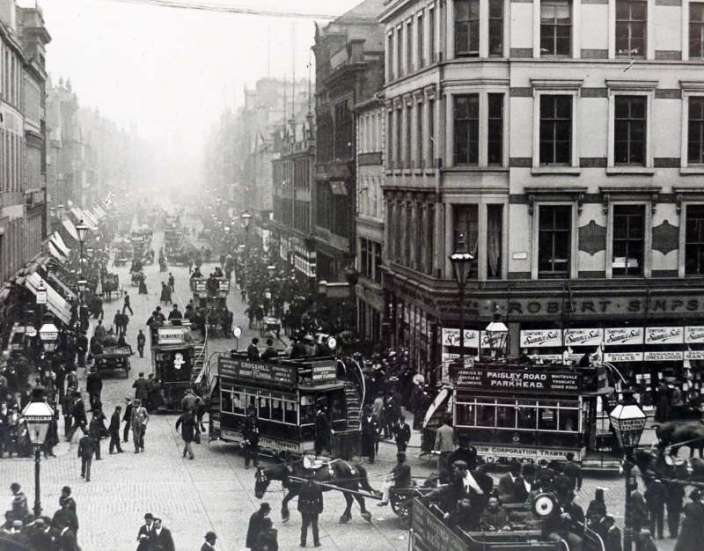
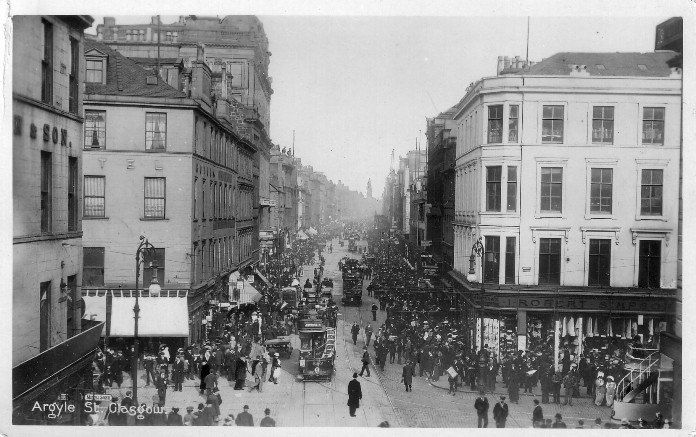
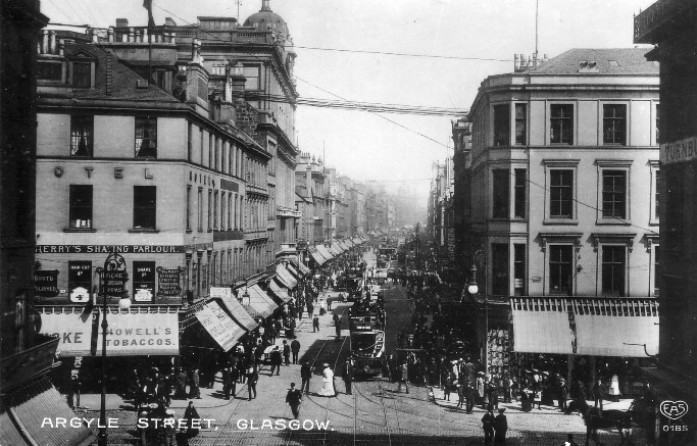
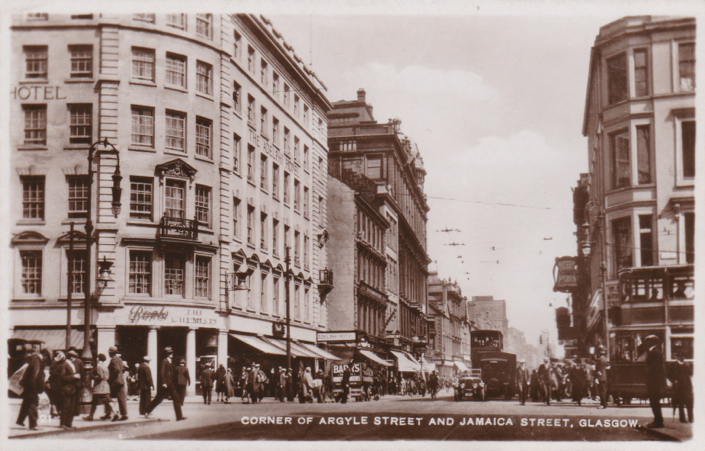
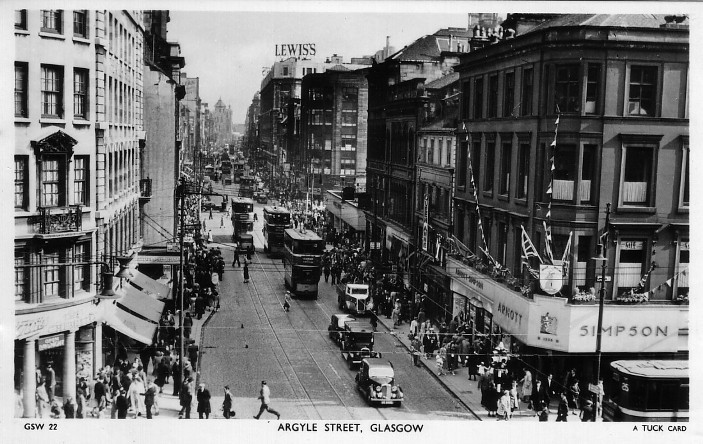
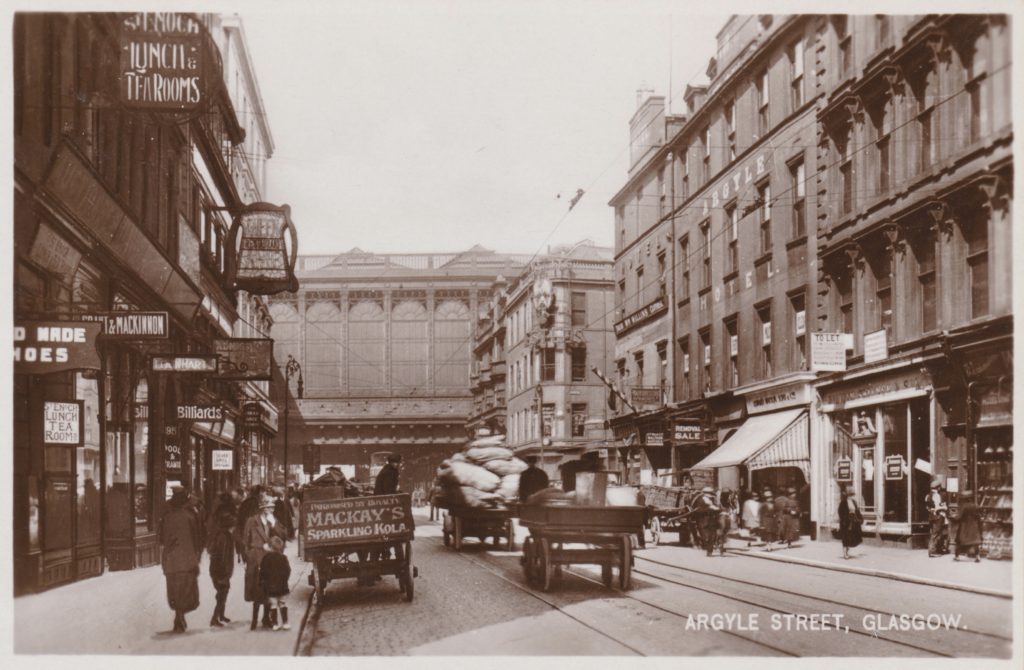
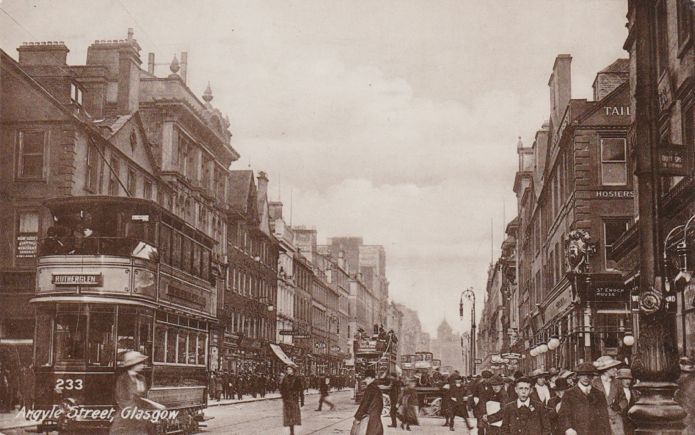
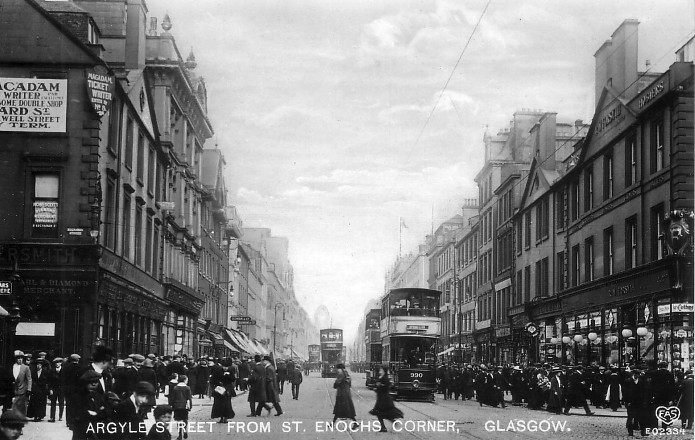
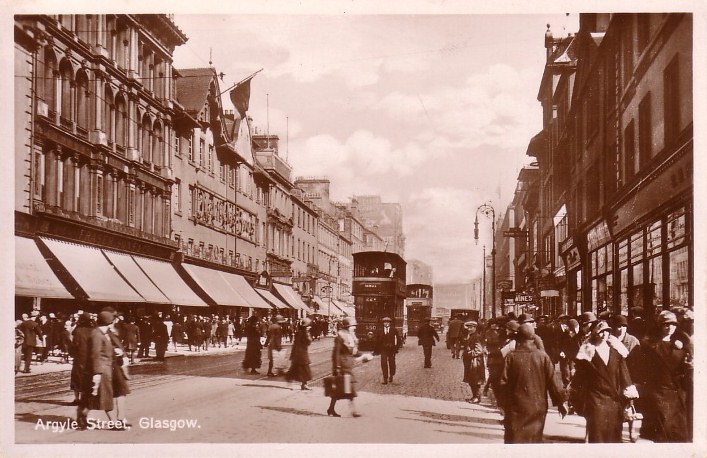
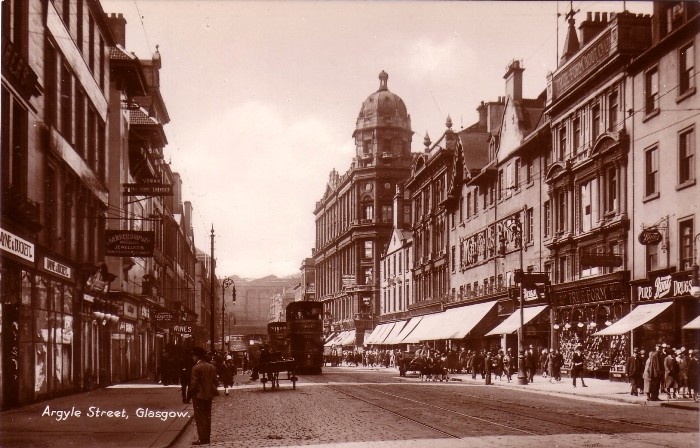
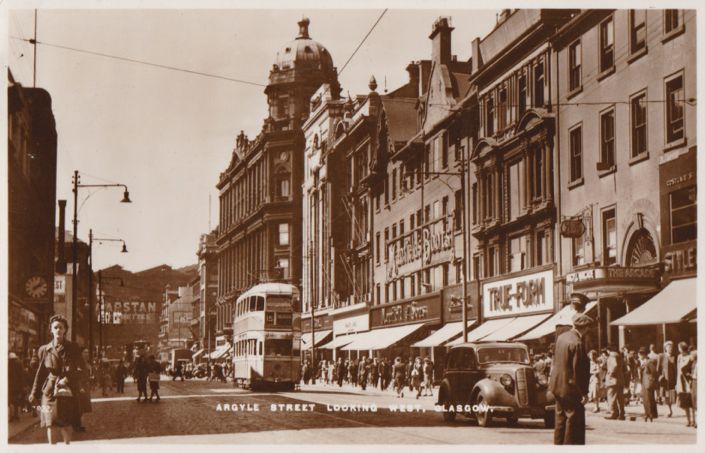
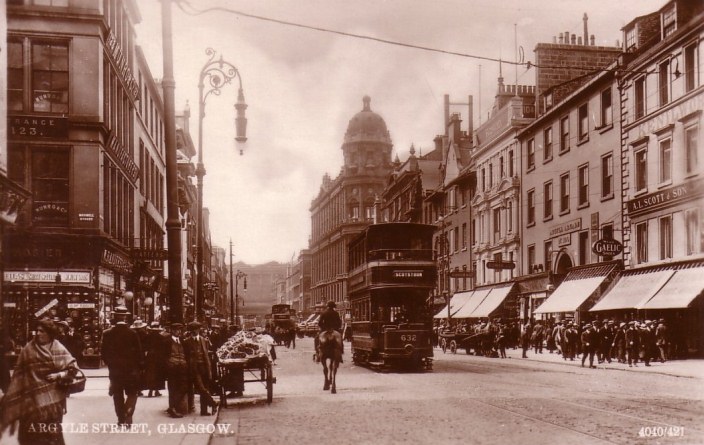
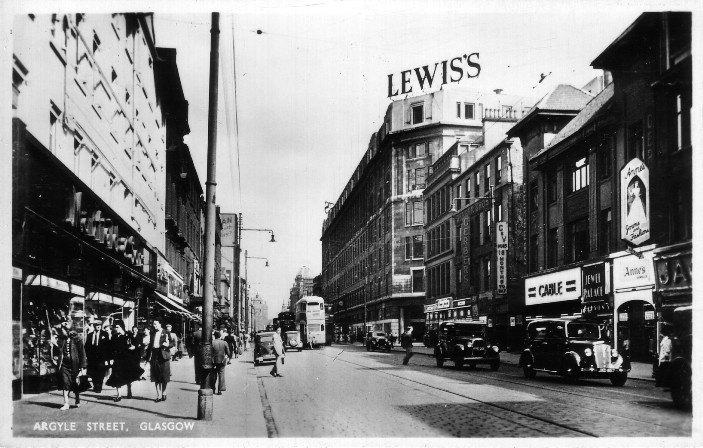
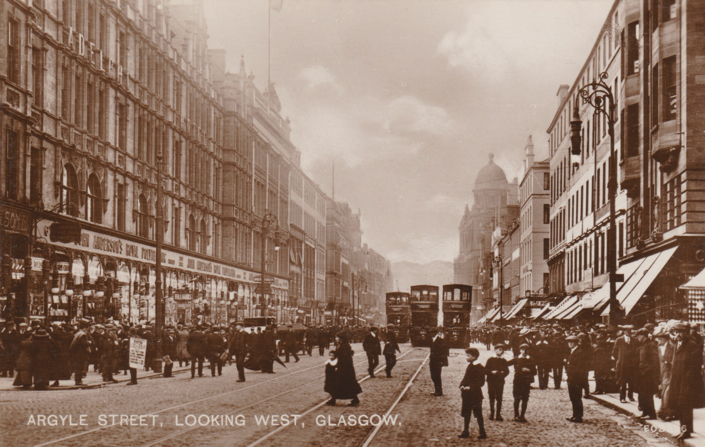
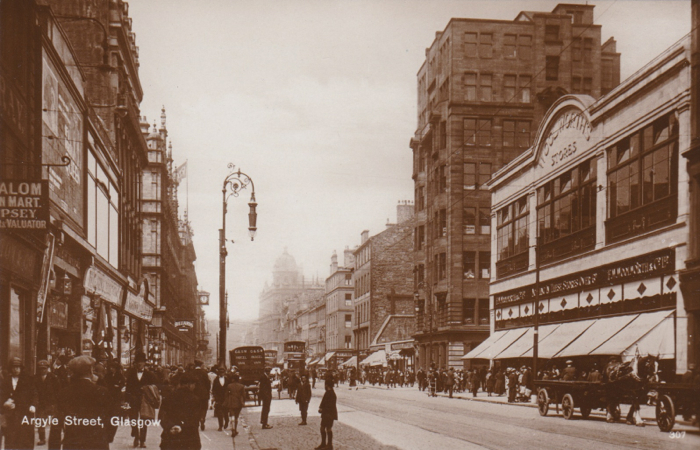
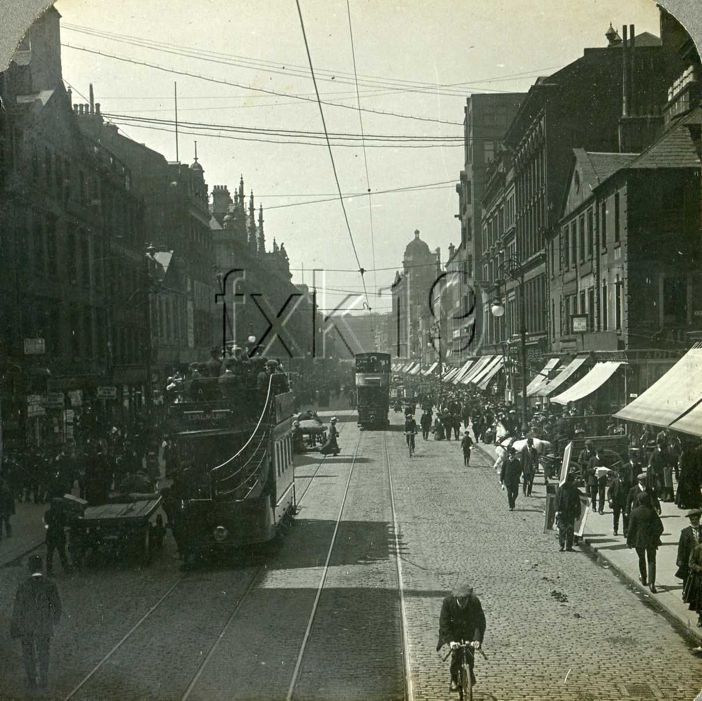
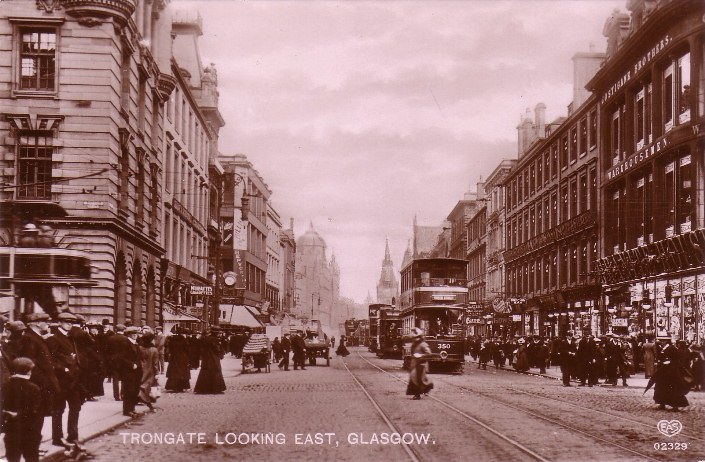

{ 7 comments… read them below or add one }
← Previous Comments
Chris,
I am researching the Monkwearmouth Charity Cup. A football trophy first contested in 1890, the proceeds going to support the local Hospital in Sunderland. The cup is the size of the European Cup and is still competed for. I have photographs.
A newspaper article from 1890 says it was made by David Gow and Sons, Jewellers etc, Argyle Street, Glasgow. You reference a Gow company of upholsterers but we’re they also jewellers?
Which street number were they? A photo would be very much appreciated.
David
Chris,
The Monkwearmouth Charity Cup – An 1890 Sunderland Echo article cites David GOW as the maker.
However, in the Scottish Referee publication 26 July 1895 is an advert for David DOW of 64 Argyll Street a jeweller specialising in Sporting trophies and medals.
Did the Sunderland Echo get it wrong?
David
Hi David,
In the Post Office Annual Glasgow Directory of 1900-1901 on page 1171 under the heading of Jewellers is listed Dow, David of 68 Argyle St. https://digital.nls.uk/directories/browse/archive/84735125
Best wishes,
Chris
Hi Chris,
Are there any photos from the 1880’s of Peter Ralston’s photographic studio. I think it was located at 195 1/2 Argyle St.
Cheers.
Peter
Hi Peter,
Thank you for your inquiry. I can confirm that there was definitely a photographer listed for the 195 1/2 Argyle Street address during the period you mention although Peter Ralston’s name was not listed for the dates that I checked. 1880 – 1881, 195 1/2 Argyle Street, Alfred Howell, Photographer; 1885 – 1886, Norma, Photographer; 1890 – 1891, John Hastie, Norma; Photographers. The location is very close to the corner with Jamaica Street.
Photographers often had a rooftop location for their studios and there was one on the opposite side of Argyle Street, at the corner with Union Street. I will check photos at the location you mention to see if I can see evidence of a studio.
Best wishes,
Chris
Hello Chris:
I am wondering if there are records of employees who worked in the department stores. I am working on our family tree and my mother-in-law worked at an upscale clothing store when she was 14 to support her family after her dad passed away. Her name was Christina Baillie and she was born in 1904. I’m not sure if this will be answered but it’s worth a try. Thank you.
Debbie McHallam
Hello Debbie,
Thank you very much for your inquiry. Do you know the name or location of the department store where your mother-in-law worked? Did it cater exclusively to women? The records of some now-closed department stores may be held by local public or university libraries. So the first task would be to find the name of the store.
Best wishes,
Chris